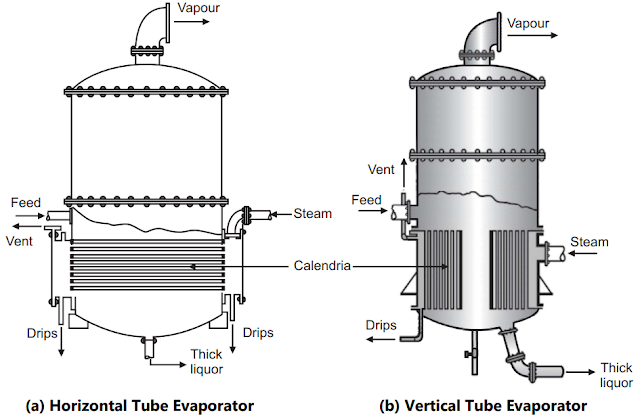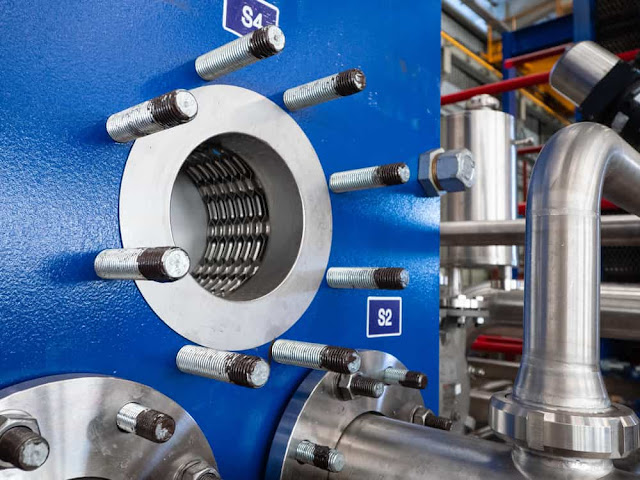A horizontal tube evaporator is frequently found to be the most adaptable choice for simple evaporation wherein liquids are not viscous and do not deposit scale or salt on the surface.
Principle of Horizontal Tube Evaporator
The principle mechanism involved in this type of evaporator is that steam is passed through tubes arranged horizontally. Heating causes evaporation of the feed outside the tubes discharging concentrate at the bottom and vapors passed out from the outlet at the top. The vapor is removed from the top of the chamber and the product circulation takes place by natural circulation over the heating coil.
Construction of Horizontal Tube Evaporator
Horizontal-tube
evaporators are designed with either rectangular or circular cross-sections,
with tubing of stainless steel, aluminum, nickel, carbon, spellerized iron
pipe, lead-covered copper, or special bronze, Fig.1 (a). The tubes are extended
between two steam chests and the arc is fastened to the tube. Four-hole packing
plates force down conical gaskets around the tube ends into counter-sunk holes
in the tube sheets. Secure sealing is obtained, with a facility for quick and
easy renewal. Horizontal tubes of 2 to 3 cm diameter are extended across the
bottom of a cylindrical chamber with 1 to 3 meters diameter and 2.5 to 4.5-meter
height. In the case of vertical tube evaporators, the tubes are arranged
vertically in calendria, Fig.1 (b). A calendria is a heating part in an evaporator
consisting of a large number of smaller diameter tubes wherein a liquid is
concentrated while rising or falling.
 |
| Fig.1: Short Tube Evaporators |
Working of Horizontal Tube Evaporator
In the horizontal-tube
evaporator, steam is fed into the steam chest and is directed through the
horizontal tubes to heat the liquid surrounding the tube in the bottom of the
evaporator body. The definite path followed by the steam assures that all
non-condensed gases and condensate are swept to the opposite steam chest, where
they are withdrawn. The velocity and paths of circulation of the liquid depend
upon the distribution, size, and shape of the heating surface in the liquid
compartment.
Applications of Horizontal Tube Evaporator
- It is used in the manufacture of the cascara extract.
- It is used in the manufacture of caustic soda.
- It is used in the manufacture of salts.
Advantages of Horizontal Tube Evaporator
- Several units can be joined to obtain a more efficient effect.
- It has a low cost per unit of heating surfaces.
- It has extreme simplicity.
- Easy renewal of heating surfaces.
- Sectional construction with low maintenance cost.
- Ease of operation.
- Ability to carry a large volume of liquor in the body.
- It requires low headspace.
- Small cargo space is required for shipment.
Disadvantages of Horizontal Tube Evaporator
- Cleaning and maintenance are difficult when compared with a steam jacketed kettle.
- During operation, the pressure inside the evaporator increases that reduces the effective temperature gradients, and may affect heat-sensitive materials.
- It may be used only when rigorous boiling can be obtained with natural circulation.
- It is not suitable for viscous liquids.
- Since the boiling liquid is outside of the tubular heating surface, it is not easily cleaned by mechanical means.
- It is not suitable when scaling or salting liquids are involved.
Make sure you also check our other amazing Article on : Evaporating Pan